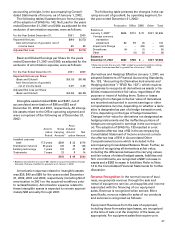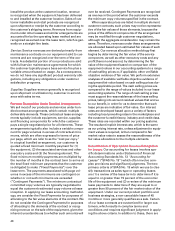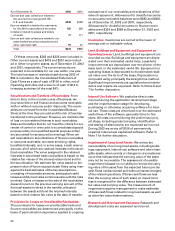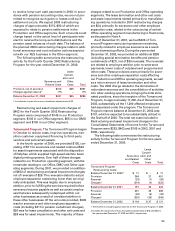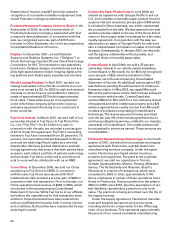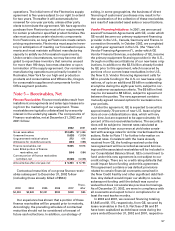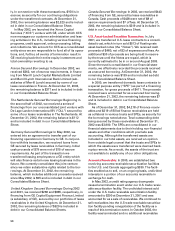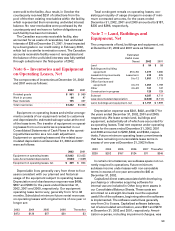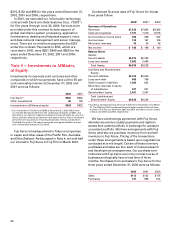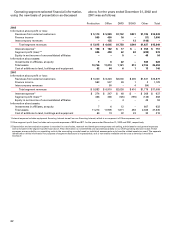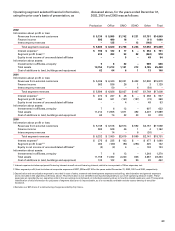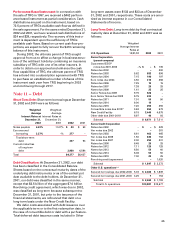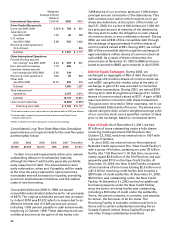Xerox 2002 Annual Report Download - page 59
Download and view the complete annual report
Please find page 59 of the 2002 Xerox annual report below. You can navigate through the pages in the report by either clicking on the pages listed below, or by using the keyword search tool below to find specific information within the annual report.
57
exiting, in some geographies, the business of direct
financing of customers’ purchases may result in fur-
ther acceleration of the collection of these receivables
as a result of associated asset sales or securitizations.
Vendor Financing Initiatives: In 2001, we announced
several Framework Agreements with GE, under which
GE would become our primary equipment-financing
provider in the U.S., Canada, Germany and France. In
connection therewith, in October 2002, we completed
an eight-year agreement in the U.S. (the “New U.S.
Vendor Financing Agreement”), under which GE
Vendor Financial Services, a subsidiary of GE, became
the primary equipment financing provider in the U.S.,
through monthly securitizations of our new lease orig-
inations. In addition to the $2.5 billion already funded
by GE prior to this agreement, which is secured by
portions of our current lease receivables in the U.S.,
the New U.S. Vendor Financing Agreement calls for
GE to provide funding in the U.S. on new lease origi-
nations, of up to an additional $5 billion outstanding
at anytime during the eight-year term, subject to nor-
mal customer acceptance criteria. The $5 billion limit
may be increased to $8 billion, subject to agreement
between the parties. The new agreement contains
mutually agreed renewal options for successive two-
year periods.
Under the agreement, GE is expected to securitize
approximately 70 percent of new U.S. lease origina-
tions at over-collateralization rates, which will vary
over time, but are expected to be approximately 10
percent of the net receivables balance. The securitiza-
tions will be subject to interest rates calculated at
each monthly loan occurrence at yield rates consis-
tent with average rates for similar market based trans-
actions. Refer to Note 11 for further information on
interest rates. Consistent with the loans already
received from GE, the funding received under this
new agreement will be recorded as secured borrow-
ings and the associated receivables will be included in
our Consolidated Balance Sheet. GE’s commitment to
fund under this new agreement is not subject to our
credit ratings. There are no credit rating defaults that
could impair future funding under this agreement.
This agreement contains cross default provisions
related to certain financial covenants contained in
the New Credit Facility and other significant debt facil-
ities. Any default would impair our ability to receive
subsequent funding until the default was cured or
waived but does not accelerate previous borrowings.
As of December 31, 2002, we were in compliance with
all covenants and expect to be in compliance for at
least the next twelve months.
In 2002 and 2001, we received financing totaling
$1,845 and $1,175, respectively, from GE, secured by
lease receivables in the U.S. Net fees of $9 and $7
have been capitalized as debt issue costs during the
years ended December 31, 2002 and 2001, respective-
operations. The initial term of the Flextronics supply
agreement is five years subject to our right to extend
for two years. Thereafter it will automatically be
renewed for one-year periods, unless either party
elects to terminate the agreement. We have agreed to
purchase from Flextronics most of our requirements
for certain products in specified product families. We
also must purchase certain electronic components
from Flextronics, so long as Flextronics meets certain
pricing requirements. Flextronics must acquire inven-
tory in anticipation of meeting our forecasted require-
ments and must maintain sufficient manufacturing
capacity to satisfy such forecasted requirements.
Under certain circumstances, we may become obli-
gated to repurchase inventory that remains unused
for more than 180 days, becomes obsolete or upon
termination of the supply agreement. Our remaining
manufacturing operations are primarily located in
Rochester, New York for our high-end production
products and consumables and Wilsonville, Oregon
for consumable supplies and components for the
Office segment products.
Note 5 — Receivables, Net
Finance Receivables: Finance receivables result from
installment arrangements and sales-type leases aris-
ing from the marketing of our equipment. These
receivables are typically collateralized by a security
interest in the underlying assets. The components of
Finance receivables, net at December 31, 2002 and
2001 follow:
2002 2001
Gross receivables $10,685 $11,466
Unearned income (1,628) (1,834)
Unguaranteed residual values 272 414
Allowance for doubtful accounts (324) (368)
Finance receivables, net 9,005 9,678
Less: Billed portion of finance
receivables, net (564) (584)
Current portion of finance receivables
not billed, net (3,088) (3,338)
Amounts due after one year, net $ 5,353 $ 5,756
Contractual maturities of our gross finance receiv-
ables subsequent to December 31, 2002 follow
(including those already billed of $564):
There-
2003 2004 2005 2006 2007 after
$4,359 $2,869 $2,031 $982 $349 $95
Our experience has shown that a portion of these
finance receivables will be prepaid prior to maturity.
Accordingly, the preceding schedule of contractual
maturities should not be considered a forecast of
future cash collections. In addition, our strategy of


